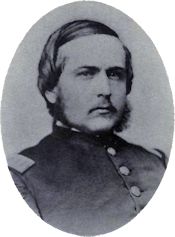Friday, July 29th.
Very quiet in front of the Fifth Corps, which is now on the extreme left, but firing is brisk in front of the Ninth. While “on fatigue” again to-day in command of the Second Battalion, I was ordered to camp to take charge of a battery of four and a half inch rifled siege guns in front of the Fifth Corps, with my Own Co. H, and a detail from Co. F, for I did not have men enough left in my company to man and work a six-gun battery. At three o’clock in the afternoon I reported in person to General Warren at his Headquarters for instructions, and there met the General, his Chief of Staff, Col. Locke, and his Chief of Artillery, Col. Wainwright. The General at the moment of my arrival was experimenting with some new kind of shells which the enemy had fired at his Headquarters, and was exploding them in a hole in the ground, but he at once took me into the house which he was occupying, and spreading on a table a large map showing the position of the various works on both sides in front of his Corps, and to the right as far as the salient under which was the mine, gave me the whole plan of attack for the following morning, including not only the part which my battery was to take but also the part which each of the Corps was to take. Indeed, so full and accurate were his descriptions of situation, distance and direction, that although I could see but a small part of the enemy’s line the next morning, I had no difficulty in dropping my heavy shells just where the General desired and avoiding our own charging columns at and near the Crater.
At five o’clock that afternoon, my First Lieutenant, Edmonston, conducted my company, with the detail from Company F, to Fort Sedgwick, which was called “Fort Hell” by the soldiers, a large earthwork in front of, and connected with, the breastworks of the Fifth Corps, and located on the Jerusalem Plank Road running into Petersburg, where I joined the command soon afterwards. About nine o’clock at night the six heavy “ordnance guns,” as they were called, all apparently new and resting in their traveling beds, with even their trunnion sights removed, drawn by mules and accompanied by ammunition wagons, all in charge of a drunken wagon-master, arrived at the foot of the “covered way” which zig-zagged up to our fort from a hollow in the rear. My men were perfectly familiar with these guns, even to the minutest details, and taking charge of them at once, by dint of hard work we had each piece in position, shifted from its traveling to its trunnion bed, its sights adjusted, a charge rammed home, its gunners at their posts, and the lanyard ready to hook to its friction primer, and the whole battery in every respect ready for business, just as the mine was exploded at about half-past four o’clock in the morning of the 30th. Five of the guns bore directly on the rebel work which was to be blown up, and the works between it and my fort, while No. 6 stood in an angle and bore on the rebel fort Mahone, or “Fort Damnation,” as it was called.



